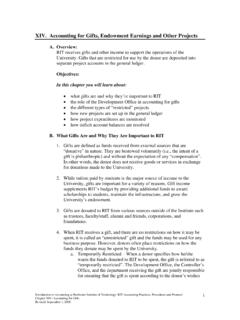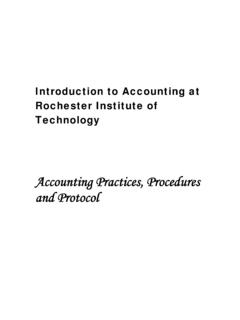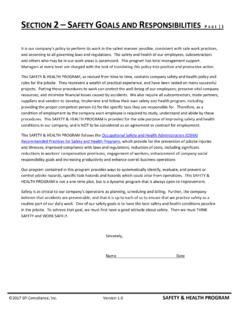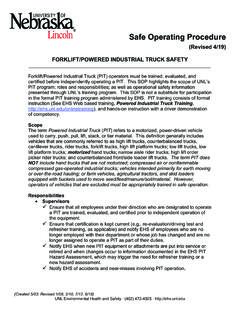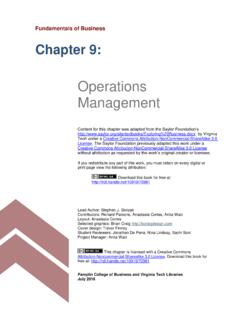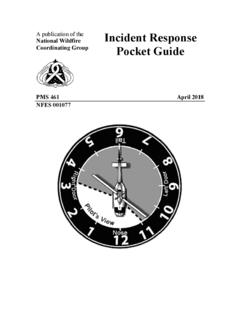Transcription of Incident Investigation Process and Exercise
1 Incident Investigation Process and Exercise INTRODUCTION An Incident is an unplanned or undesired event that adversely affects a company s work operations. Incidents include work-related injuries, occupational illnesses, property damage, spills, fires or near miss events that could have resulted in any of these. All incidents should be investigated. An Incident that results in a serious employee injury, considerable property damage, a major fire, or spill obviously warrants an extensive Investigation . A minor Incident or near Incident also requires a thorough Investigation and may reveal significant potential for a serious Incident if the conditions are left uncorrected. There are two major components that contribute to the cause of an Incident . They are the work element and the root cause . The work element is the condition or act that directly caused the Incident . An example of a work element might be a small spill of oil on the floor that someone slipped on.
2 The root cause is the system failure that allowed the work element to become deficient or to occur. For example, a root cause may be a lack of preventive maintenance that resulted in the fork truck leaking oil on the floor. A thorough Investigation will reveal the root cause of the Incident . The purpose of an Incident Investigation is to determine the work element and root causes of Incident , and to assist in providing the company with a solution to prevent recurrence. Companies should have an Incident Investigation Process to ensure that: All incidents (including near misses) are investigated Corrective action are determined that identify the root cause Corrective actions are tracked until they are completed Trends are reviewed, gaps are identified and improvement plans are developed to prevent future occurrences. Investigation Process Proper training and a clear understanding of roles and responsibilities is essential to the Investigation Process .
3 All employees and people that will be involved in an Incident Investigation should be aware of what their role is in the Process and how to perform their assigned responsibilities during an Investigation Process . Employees: Report all work-related incidents in a timely manner Participate in the Investigation Process , as needed Supervision/Management: If the Incident was very recent, secure the scene of the Incident to ensure the safety of any emergency responders and other employees, and to preserve any evidence that may contribute to the Investigation Ensure the injured person is properly cared for Ensure management or other company personnel who require it are notified. OSHA or another government agency may also be required to be notified, depending on the type and/or severity of an Incident . (For example, in OSHA 1904, recordkeeping requirements require that any fatality, or any hospitalization of 3 or more persons because of a work related Incident be reported to OSHA within 8 hours of the Incident .)
4 Ensure the Investigation begins as soon as possible after the Incident occurs Identify the potential sources of information, such as the injured person, witnesses and any physical evidence Gather the facts about the Incident Ensure the Investigation identifies the root cause Make and/or implement recommendations to control or eliminate the hazard Ensure all regulatory and company requirements are met (OSHA recordkeeping, notification, written reports, insurance claims, etc.) perform any trend analyses of past incidents that may identify additional hazard prevention methods ( training, maintenance, procedures, etc.) The ultimate responsibility for an Incident Investigation rests with management. Supervisors must take charge of a thorough Incident Investigation . Depending upon the type and scope of an Incident ( major spill or fire, or several employees injured in one Incident ), a team approach to the Investigation of the Incident may identify additional corrective actions that will help prevent similar incidents in the future.
5 Investigations must be constructive, credible and timely. Remember that the investigator is trying to figure out what happened and how to prevent similar situations, not trying to place blame on any individual or group. If the Investigation is antagonistic, and takes a what did you do wrong? approach, then the Process becomes much more difficult, as employees do not want to be blamed or cooperate in a blame-giving situation. A more constructive approach is what happened, and what can we do to prevent this from happening again? Timing of an Incident Investigation could be crucial to the outcome. If an employee reports an Incident that happened three weeks ago, all an investigator has to go on is what can be remembered by the persons involved. People s memories fade or evidence may be disturbed which could hamper the Investigation Process . With timely reporting, an Investigation can take significantly less time to complete, and operations will be able to resume more quickly.
6 GATHER EVIDENCE One of the most critical and complex parts of the Investigation is the gathering of evidence. There are some basic rules that may help the Process . Interviewing involved employees: Put the individual at ease make sure they know the primary purpose of the interview is to prevent a recurrence of the Incident and that it can only be done with their help. Avoid finger-pointing and applying blame. Treat people with tact and respect. Make them aware that they need to be thorough and truthful in their account of the Incident and that you are not there to get anyone into trouble, only to find out what happened and why, so that it won t happen again. Be aware that injured employees and witnesses to injuries may have some emotions involved that affect them. Especially if the Incident was severe, there may be some trauma that occurs. Stress fact gathering. Let involved employees tell their story completely.
7 Wait until they have finished their version of events before interrupting or clarifying what was said. Then go over what they stated with them, to assure that you have their account of the story accurately and that you understand what they meant, not just what they said. Do not make assumptions or state opinions during this Process . If other people have said something different from what was stated in this interview, ask leading questions to discover more information, but do not contradict what was stated in either interview. Conduct the interviews at the scene, if possible. This may help people to explain and may help the interviewer understand what happened. Make the interviews as private as possible, so that other employees cannot take any offense or contradict what is said. Witnesses may be interviewed at a later time, if privacy is at issue. Ask any necessary questions to determine what happened, what was done, and how it was done.
8 Try to avoid asking WHY questions that may make people defensive. Close the interview on a positive note. Discuss the actions taken, or that will be taken if you know them. That will reaffirm the purpose of the interview. Make sure you thank the interviewee for their help in the Investigation Process . Use the right tools during the Investigation Process : Paper and pencil is the basic tool. Taking notes can jog a memory later on when you are writing any Investigation or Incident reports. Record times, places, names, distances, comments, conditions or anything else you may think will help. take pictures, if possible. A picture is worth a thousand words. take an overall picture first to keep an idea of where the Incident took place. Then get any close up shots of spilled material, machinery or equipment that may have been involved. If needed, place a ruler or other object that is of a known size in the picture, so that you can more easily determine size or scale within the picture.
9 Draw a sketch or diagram. This is useful especially when the Incident is complex. Use the diagram to indicate where key objects or people were during the Incident . DETERMINE THE ROOT CAUSE Many times it is easy to determine what the work element is that directly caused the Incident . It could have been a flying chip, a spill on the floor, or lifting a load that was too heavy. However, discovering the system failure that allowed the deficient work element to occur is sometimes more difficult. This system failure is also known as the root cause. To make it easier to determine, root causes (in general) can be placed into six different categories. Some examples of each of these root cause elements are as follows: Materials Machine/Equipment - Defective raw material(s) - Wrong type of material for job - Not enough raw material - Incorrect selection of tool or equipment - Poor equipment maintenance or design - Poor equipment or tool placement - Defective equipment or tool Environment Man - Orderly workplace - Job design or layout of work - Surfaces poorly maintained - Physical demands of the task - Other conditions (noise, lighting, etc.)
10 - No or poor management involvement - Inattention to task - Task hazards not guarded properly - Other (horseplay, inattention, etc.) - Stress demands Methods Management System - No or poor procedures - Practice does not mesh with written procedures - Poor communication - Training or education lacking - Poor employee involvement - Poor recognition of hazard - Previously identified hazards were not eliminated Basic elements of root cause: man material machine methods environment Incident management system DOCUMENT THE FINDINGS A well conducted Investigation identifies the work element(s) that caused the Incident and helps to eliminate the root cause(s). After the Investigation is completed, the investigator then begins to document the Incident and their findings. The Incident documentation should contain specific elements. When the Incident happened. Date and time may be crucial because of work load or shift change.




